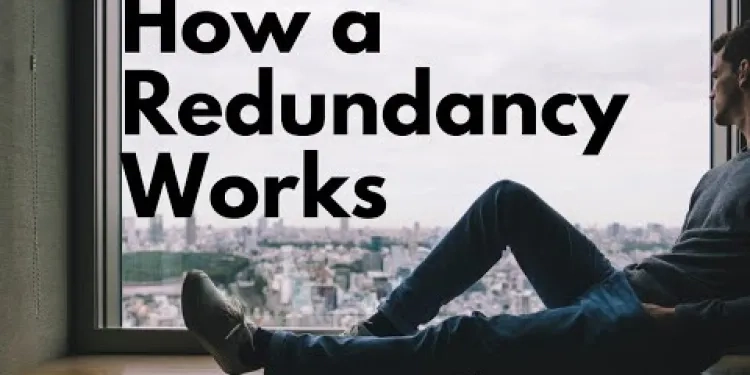Find Help
More Items From Ergsy search
-

Redundancy Crusader and Annabel Kaye on the Current Model of Redundancy (1).MTS
Relevance: 100%
-

Redundancy Coaching Couch 7: Redundancy and Judgement.MTS
Relevance: 55%
-

Redundancy Coaching Couch 4:Redundancy and Language
Relevance: 55%
-

Redundancy Coaching Couch 5: Redundancy and Feedback.MTS
Relevance: 55%
-

Redundancy Coaching Couch 1: Redundancy and Presuppositions
Relevance: 55%
-

Redundancy Coaching Couch 2: Redundancy and Passion
Relevance: 54%
-

Redundancy Crusader and Annabel Kaye on communications in redundancy (5).MTS
Relevance: 52%
-

Redundancy Crusader and Annabel Kaye on scope and scale of redundancy (3).MTS
Relevance: 51%
-

Redundancy Crusader and Annabel Kaye on making redundancy a better experience (2).MTS
Relevance: 50%
-

Redundancy Coaching Couch 3: States
Relevance: 49%
-

HOW A REDUNDANCY WORKS - General Information
Relevance: 48%
-

Frequently asked questions about redundancy from ACAS
Relevance: 46%
-

Can hypothesized variants be used in scientific modeling?
Relevance: 46%
-

What is the current EV grant amount in the UK?
Relevance: 32%
-

What are the current statistics on childhood obesity in the UK?
Relevance: 25%
-

What is the current threshold for Stamp Duty in the UK?
Relevance: 25%
-

What is the current measles vaccination coverage in the UK?
Relevance: 25%
-

Addressing the Housing Crisis: Current Challenges and Solutions
Relevance: 23%
-

Are there any Zika virus outbreaks currently?
Relevance: 23%
-

Current Flu Vaccination Recommendations and Availability
Relevance: 23%
-

Where can I find reviews from current or past National Trust employees?
Relevance: 21%
-

Current Challenges in Youth Mental Health Services
Relevance: 20%
-

Are there any countries currently implementing a wealth tax?
Relevance: 20%
-

What is the current inheritance tax threshold in the UK?
Relevance: 20%
-

Are Audi electric vehicles available in the UK?
Relevance: 19%
-

Is Tesla available in the UK?
Relevance: 19%
-

Are age restrictions currently in place for social media platforms in the UK?
Relevance: 17%
-

Are there any electric vehicles from BMW available in the UK?
Relevance: 17%
-
Can current treatments handle new COVID-19 variants?
Relevance: 16%
-

How does the EV grant affect the purchase price?
Relevance: 15%
-

Does Kia sell electric cars in the UK?
Relevance: 15%
-

Does MG offer any electric vehicles in the UK?
Relevance: 15%
-

Understanding Your Rights: Legal Support for Families During Economic Turbulence
Relevance: 14%
-

Does Renault offer electric vehicles in the UK?
Relevance: 14%
-

How do I find out if a specific car is eligible for the Plug-in Car Grant?
Relevance: 14%
-

What electric vehicles does Skoda offer in the UK?
Relevance: 14%
-

What electric cars does Hyundai offer in the UK?
Relevance: 14%
-

AI Breast Cancer Screening in the UK
Relevance: 13%
-

Are there electric vans available in the UK?
Relevance: 13%
-

Are there any electric vehicles from Peugeot available in the UK?
Relevance: 13%
Redundancy Crusader and Annabel Kaye on the Current Model of Redundancy
Redundancy Crusader: Advocating for Change
The Redundancy Crusader is a movement in the United Kingdom committed to challenging and reforming the existing redundancy processes. This group believes the current model is outdated and does not adequately protect employees, leading to undue stress and financial instability for workers affected by redundancy. By raising awareness and pushing for legislative changes, the Redundancy Crusader aims to create a fairer system that balances the needs of both employers and employees.Annabel Kaye: A Voice for Workers' Rights
Annabel Kaye, a renowned HR expert and co-founder of Irenicon Ltd, has been a significant advocate for workers' rights in the UK. With over 40 years of experience in employment law and HR consultancy, Kaye has provided invaluable insights into the inadequacies of the current redundancy model. She argues that redundancy should not be a tool for employers to easily offload employees during tough times without appropriate safeguard for those workers' rights and future security.The Current Model of Redundancy
The current redundancy model in the UK allows employers to lay off staff when their roles become unnecessary to the business due to economic downturns, restructuring, or business closures. However, critics like the Redundancy Crusader and Annabel Kaye highlight several flaws: 1. **Lack of Support**: Employees often receive minimal support during the redundancy process, leading to significant financial and emotional distress. 2. **Inadequate Notice**: The required notice period is often insufficient for affected employees to secure new employment, adding to job insecurity. 3. **Insufficient Compensation**: The statutory redundancy pay is frequently deemed inadequate, failing to provide a sufficient financial buffer for those facing unemployment. 4. **Limited Retraining Opportunities**: There's a general lack of provisions for retraining and upskilling, which could help redundant employees transition into new roles more effectively.The Call for Reform
Both the Redundancy Crusader and Annabel Kaye are calling for comprehensive reforms to the redundancy model, including: 1. **Enhanced Employee Support**: Ensuring employees have access to counselling and job placement services. 2. **Extended Notice Periods**: Proposing longer notice periods to give employees more time to find new roles. 3. **Increased Redundancy Pay**: Advocating for higher redundancy payments to reflect the true cost of job loss. 4. **Retraining Programs**: Encouraging the implementation of mandatory retraining schemes funded by employers or government to help workers reskill. Through these efforts, the Redundancy Crusader and Annabel Kaye aim to modernize the redundancy framework, ensuring it is fair and just for all stakeholders involved.Redundancy Crusader and Annabel Kaye on What Redundancy Means Today
Redundancy Crusader: Fighting for Change
Redundancy Crusader is a group in the UK. They want to change how redundancy works. They think the way it is now is old and unfair. It can make workers stressed and worried about money. They want new rules to make things fair for everyone—both workers and bosses.Annabel Kaye: Speaking Up for Workers
Annabel Kaye is an expert in workers' rights. She has worked in this field for more than 40 years. She thinks the current redundancy system is not fair. It should not be easy for bosses to let workers go just because times are tough. Workers need protection and a secure future.What Redundancy Means Now
Right now in the UK, bosses can let staff go if their jobs aren't needed anymore. This can happen if the business is not doing well or needs to change. But some people, like Redundancy Crusader and Annabel Kaye, say there are problems with this: 1. **Not Enough Help**: Workers don’t get much help during redundancy, which can make things very hard for them. 2. **Short Notice**: Workers often get told too late, making it hard to find new jobs. 3. **Low Redundancy Pay**: The money workers get when they lose their job isn't enough to help them while they look for new work. 4. **Few Retraining Options**: There are not many chances for workers to learn new skills and find different jobs.The Need for Change
Redundancy Crusader and Annabel Kaye want big changes in how redundancy works: 1. **More Support for Workers**: Workers should get help like advice and assistance finding new jobs. 2. **Longer Notice Times**: Workers should get more time to find new jobs before they have to leave. 3. **Better Redundancy Pay**: The money given to workers should be more to help cover time without a job. 4. **Training Programs**: Encourage training programs paid by bosses or the government to help workers learn new skills. By making these changes, Redundancy Crusader and Annabel Kaye hope to make redundancy fairer for all. If you are affected by redundancy, consider finding support groups or using online job search tools to help you through the process.Frequently Asked Questions
What is the primary purpose of redundancy?
The primary purpose of redundancy is to reduce costs and improve efficiency by eliminating roles that are no longer necessary within an organization.
What are the legal requirements for redundancy in the UK?
In the UK, redundancy must follow a fair process including consultation, fair selection criteria, and consideration of alternative employment within the company.
How should companies consult employees about redundancy?
Companies must consult employees individually and, if more than 20 employees are affected, there must be a collective consultation with employee representatives or a trade union.
What is redundancy pay and who is eligible for it?
Redundancy pay is compensation given to employees who are dismissed due to redundancy. Employees with at least two years of continuous service are eligible.
How is redundancy pay calculated in the UK?
Redundancy pay is calculated based on age, length of service, and weekly pay, up to a statutory maximum limit.
Can an employee appeal a redundancy decision?
Yes, employees have the right to appeal a redundancy decision if they believe it was unfair or if the proper process was not followed.
What is the notice period for redundancy?
The notice period for redundancy varies by duration of employment, ranging from one week to 12 weeks, depending on the length of service.
What alternatives should be considered before redundancy?
Employers should consider alternatives such as redeployment, retraining, voluntary redundancy, or reduced working hours before proceeding with redundancy.
What support can employees expect during redundancy?
Employees can expect support such as career counseling, access to job placement services, and possibly training or reskilling opportunities.
What is a fair selection process for redundancy?
A fair selection process involves using objective criteria such as skills, performance, and attendance records, rather than discriminatory factors.
What happens if an employer does not follow the redundancy process?
If the employer does not follow the proper redundancy process, employees may be able to claim unfair dismissal at an employment tribunal.
Are there any protections for employees on maternity leave during redundancy?
Yes, employees on maternity leave have additional protections and must be offered any suitable alternative employment in preference to other employees.
Can employees request voluntary redundancy?
Yes, employees can request voluntary redundancy, but it is up to the employer to decide whether to accept the request.
What is the role of trade unions in the redundancy process?
Trade unions can represent employees during consultations, help ensure fair treatment, and negotiate redundancy terms and conditions with the employer.
How should employers manage the emotional impact of redundancy on employees?
Employers should offer emotional support such as counseling services, communicate transparently, and provide reassurance about the fairness of the process.
Why do we use redundancy?
The main reason for redundancy is to save money and work better by getting rid of jobs that the company does not need anymore.
What are the rules for losing a job in the UK?
In the UK, if someone loses their job because of redundancy, the company must do certain things. They need to talk to the worker, use fair reasons to choose who loses their job, and see if there is another job in the company that the worker can do.
How can companies talk to workers about losing their jobs?
It is important for companies to talk with workers if their jobs might go away.
Here are some tips to make it easier:
- Use simple words when you talk.
- Ask workers what they think.
- Give workers time to ask questions.
- Listen carefully to their feelings.
- Help them understand what will happen next.
- Use pictures or charts to explain things.
These steps can help everyone understand better.
Businesses need to talk with each worker one by one. If 20 or more workers are affected, they also need to talk with a group of worker leaders or a union.
What is redundancy pay and who can get it?
Redundancy pay is money you get if you lose your job because you are not needed anymore.
You can get redundancy pay if:
- You have worked at the job for at least 2 years.
- Your job is going away and it is not your fault.
If you need help, you can:
- Ask someone to explain it to you.
- Use a dictionary to look up words.
- Use a text-to-speech tool to read it aloud.
Redundancy pay is money given to workers who lose their jobs because their role is no longer needed. Workers who have worked for the same employer for at least two years can get this money.
How is redundancy pay worked out in the UK?
If you lose your job because of redundancy, you might get some money called redundancy pay. This is to help you when your job ends.
Here is how they work it out:
- How long you have worked: They look at how many years you have worked in the job before you were made redundant.
- Your age: Your age matters. They use your age to work out how much you will get for each year you have worked.
- Your pay: They look at how much you earn each week. This is your weekly pay before tax and other things are taken away.
You can use a calculator to help you work this out! There are online tools that can do this for you. If you are unsure, ask someone to help, like a family member or a friend. You can also ask for help from a worker's support group.
Redundancy pay is money you get if you lose your job. It depends on three things: how old you are, how long you worked at the job, and how much you get paid each week. There is a maximum amount you can get.
Here are some tools to help understand big words:
- Online Dictionary: Use a dictionary to look up hard words.
- Text-to-Speech: Listen to the text being read aloud.
Can a worker ask for a change if they lose their job?
If a worker is told they will lose their job, they might feel this is not fair. Workers can ask for a change. This is called an "appeal."
To help understand and ask for a change, workers can:
- Talk to a friend or family member.
- Ask a worker's union for help.
- Use a computer to fill out a form.
It's important to act quickly. Ask for help if you need it.
Yes, workers can say "No" if they think losing their job wasn’t fair. They can also say "No" if the rules weren’t followed.
How much warning do you get if you lose your job?
The time you must wait before leaving a job because it's ending is different for everyone. It depends on how long you worked there. It can be as short as one week or as long as 12 weeks.
What else can we try before job cuts?
Before letting someone go, bosses should think about other options. They could move the person to a different job, teach them new skills, ask if they want to leave by choice, or give them fewer working hours.
How can workers get help when they lose their jobs?
When a worker loses their job, it's called redundancy. Here is how workers can get help:
- Money Help: Workers might get some money to help them after losing their job. Ask your boss about it.
- Finding a New Job: Some companies help workers find new jobs. They might offer advice or show you where to look.
- Job Training: Workers can learn new skills to find a different job. Check if your workplace offers this.
- Talking to Someone: It’s okay to feel upset. Talking to someone can help you feel better. Find someone you trust or a counselor.
If you need help, ask your boss or talk to someone you trust who can give you advice.
Workers can get help like talking about jobs, finding new jobs, and maybe learning new skills.
What is a fair way to choose people for redundancy?
When a company has to let some workers go, it needs to choose in a fair way. This means everyone should have an equal chance. Here are some simple steps to help:
- The company should let everyone know what is happening. They need to talk to the workers and explain why some people might lose their jobs.
- The company should have clear rules on how they choose who stays and who goes. This could be based on things like how long a worker has been with the company or their skills.
- The company should listen to workers’ ideas too. Workers can help come up with fair ways to decide.
- If someone doesn’t agree with why they were chosen, they should have a chance to ask questions and get answers.
Here are some tools and techniques to help:
- Talk to someone: It can help to talk to a friend or a worker's representative to understand things better.
- Write down your questions: If you have questions, write them down so you don’t forget to ask them.
- Use simple language: Ask for things to be explained in a way that is easy to understand.
- Seek support: If it feels too hard, it’s okay to ask for help from someone who can explain the information to you.
A fair choice means picking someone by looking at their skills, how well they do their job, and if they come to work a lot. We should not pick people for unfair reasons.
What happens if a boss does not follow the rules for letting people go?
Letting people go from their job is called redundancy. Bosses have to follow certain rules to do this in a fair way.
If a boss does not follow the rules, it could be unfair. Here is what might happen:
- The person might get more money.
- The person might be able to get their job back.
- The boss might have to explain why they did not follow the rules.
If you are worried about losing your job, you can talk to someone about it. Here are some ideas:
- Speak to a friend or family member.
- Contact a worker's help group.
- Use an easy-to-read website.
It is important to know your rights and get help if you need it.
If your boss does not follow the right steps when making people leave their jobs, workers might be able to say it was not fair. They can tell a special court called an employment tribunal.
Do workers who are having a baby have any safety if they might lose their job?
If you are having a baby and worried about your job, here are some things that can help:
- Talk to your boss or manager about your worries.
- Ask to see the rules about keeping your job.
- You can talk to someone who helps with work problems, like a union or a work advisor.
- Keep all letters and emails from your job about your work.
Yes, when a person is on maternity leave from work, they have extra protection. They should be given any other suitable job before other workers.
Can workers ask to leave their job and get money for it?
If workers want to leave their job and get paid, they can ask their boss. This is called asking for "voluntary redundancy."
Here is how you can ask:
- Talk to your boss or manager.
- Say you want voluntary redundancy.
- Ask if it is possible to get money when you leave.
It helps to write down your reasons for leaving. This way, you and your boss can understand what you want.
If you find this hard, you can:
- Ask a friend to help you talk to your boss.
- Write a short letter or email.
You can ask to leave your job if the company is letting people go. But your boss decides if they say yes or no.
What do trade unions do when people lose their jobs?
Trade unions help workers if they might lose their jobs. They speak up for workers. They try to make sure the process is fair. They talk to bosses to get a better deal for workers. They also give advice and support to workers.
If you need more help understanding, you can:
- Ask someone to explain it to you.
- Use pictures or videos to learn more.
- Use simple language tools on the internet.
Trade unions can help workers in meetings with their bosses. They make sure workers are treated fairly and talk to bosses about job loss rules.
What can bosses do to help workers feel better if they lose their job?
Losing a job can make people feel sad. Bosses can do things to help. Here are some ideas:
- Talk to the workers in a kind way.
- Explain why the job is going away.
- Let workers ask questions and give them honest answers.
- Offer support, like talking to someone who can help.
- Help them find new jobs, like giving them tips for interviews.
Using pictures and simple words can also help workers understand.
Bosses should help by giving people someone to talk to, like a counselor. They should talk honestly and let everyone know the process is fair.
Useful Links
- Ergsy carfully checks the information in the videos we provide here.
- Videos shown by Youtube after a video has completed, have NOT been reviewed by ERGSY.
- To view, click the arrow in centre of video.
- Most of the videos you find here will have subtitles and/or closed captions available.
- You may need to turn these on, and choose your preferred language.
- Go to the video you'd like to watch.
- If closed captions (CC) are available, settings will be visible on the bottom right of the video player.
- To turn on Captions, click settings .
- To turn off Captions, click settings again.
More Items From Ergsy search
-

Redundancy Crusader and Annabel Kaye on the Current Model of Redundancy (1).MTS
Relevance: 100%
-

Redundancy Coaching Couch 7: Redundancy and Judgement.MTS
Relevance: 55%
-

Redundancy Coaching Couch 4:Redundancy and Language
Relevance: 55%
-

Redundancy Coaching Couch 5: Redundancy and Feedback.MTS
Relevance: 55%
-

Redundancy Coaching Couch 1: Redundancy and Presuppositions
Relevance: 55%
-

Redundancy Coaching Couch 2: Redundancy and Passion
Relevance: 54%
-

Redundancy Crusader and Annabel Kaye on communications in redundancy (5).MTS
Relevance: 52%
-

Redundancy Crusader and Annabel Kaye on scope and scale of redundancy (3).MTS
Relevance: 51%
-

Redundancy Crusader and Annabel Kaye on making redundancy a better experience (2).MTS
Relevance: 50%
-

Redundancy Coaching Couch 3: States
Relevance: 49%
-

HOW A REDUNDANCY WORKS - General Information
Relevance: 48%
-

Frequently asked questions about redundancy from ACAS
Relevance: 46%
-

Can hypothesized variants be used in scientific modeling?
Relevance: 46%
-

What is the current EV grant amount in the UK?
Relevance: 32%
-

What are the current statistics on childhood obesity in the UK?
Relevance: 25%
-

What is the current threshold for Stamp Duty in the UK?
Relevance: 25%
-

What is the current measles vaccination coverage in the UK?
Relevance: 25%
-

Addressing the Housing Crisis: Current Challenges and Solutions
Relevance: 23%
-

Are there any Zika virus outbreaks currently?
Relevance: 23%
-

Current Flu Vaccination Recommendations and Availability
Relevance: 23%
-

Where can I find reviews from current or past National Trust employees?
Relevance: 21%
-

Current Challenges in Youth Mental Health Services
Relevance: 20%
-

Are there any countries currently implementing a wealth tax?
Relevance: 20%
-

What is the current inheritance tax threshold in the UK?
Relevance: 20%
-

Are Audi electric vehicles available in the UK?
Relevance: 19%
-

Is Tesla available in the UK?
Relevance: 19%
-

Are age restrictions currently in place for social media platforms in the UK?
Relevance: 17%
-

Are there any electric vehicles from BMW available in the UK?
Relevance: 17%
-
Can current treatments handle new COVID-19 variants?
Relevance: 16%
-

How does the EV grant affect the purchase price?
Relevance: 15%
-

Does Kia sell electric cars in the UK?
Relevance: 15%
-

Does MG offer any electric vehicles in the UK?
Relevance: 15%
-

Understanding Your Rights: Legal Support for Families During Economic Turbulence
Relevance: 14%
-

Does Renault offer electric vehicles in the UK?
Relevance: 14%
-

How do I find out if a specific car is eligible for the Plug-in Car Grant?
Relevance: 14%
-

What electric vehicles does Skoda offer in the UK?
Relevance: 14%
-

What electric cars does Hyundai offer in the UK?
Relevance: 14%
-

AI Breast Cancer Screening in the UK
Relevance: 13%
-

Are there electric vans available in the UK?
Relevance: 13%
-

Are there any electric vehicles from Peugeot available in the UK?
Relevance: 13%


